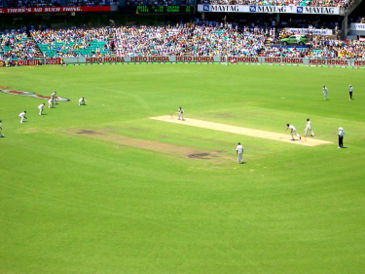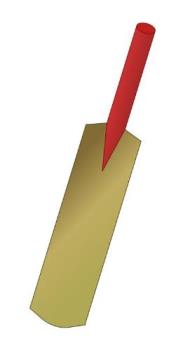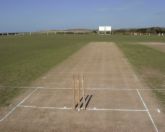Cricket Information
By kingadnan
@kingadnan (1538)
Pakistan
December 18, 2006 12:40pm CST
Cricket is a bat and ball sport, played between two teams each of eleven players. A cricket match is played on a grass field (which is usually roughly oval), in the centre of which is a flat strip of ground 22 yards (20.12 m) long, called a pitch. At each end of the pitch is a set of wooden stumps, called a wicket. A player from the fielding team (the bowler) propels a hard, fist-sized cork-centred leather ball from one wicket towards the other. The ball usually bounces once before reaching a player from the opposing team (the batsman), who defends the wicket from the ball with a wooden cricket bat. The batsman, if he or she does not get out, may then run between the wickets, exchanging ends with another batsman (the "non-striker"), who has been standing in an inactive role near the bowler's wicket, to score runs. The other members of the bowler's team stand in various positions around the field as fielders. The match is won by the team that scores more runs.
Cricket has been an established team sport for hundreds of years. It originated in its modern form in England and is popular mainly in the present and former members of the Commonwealth. In some countries in South Asia, including India, Pakistan, Bangladesh, and Sri Lanka, cricket is the most popular sport. It is also a major sport in England and Wales, Australia, New Zealand, South Africa, Zimbabwe, Bermuda, and the English-speaking countries of the Caribbean, which are collectively known in cricketing parlance as the West Indies. There are also well established amateur club competitions in countries as diverse as the Netherlands, Ireland, Kenya, Nepal, and Argentina (see also: International Cricket Council).
The sport is followed with passion in many different parts of the world. It has even occasionally given rise to diplomatic outrage, the most notorious being the Basil D'Oliveira affair which led to the banning of South Africa from sporting events. Other examples include the Bodyline series played between England and Australia in the early 1930s, an event that almost meant diplomatic ties were severed between the two nations, or the 1981 underarm bowling incident involving Australia and New Zealand.
Summary:-
The aim of the batting team is to score as many runs as possible. A run is scored when both batsmen successfully move to their respective opposite ends of the pitch(wicket). (The batsmen will usually only attempt to score runs after the striker has hit the ball, but this is not necessary). The aim of the bowler's team is to get each batsman out (this is a wicket, or a dismissal). Dismissals are achieved in a variety of ways. The most direct way is for the bowler to evade the batsman's guard and successfully hit his stumps with the ball, dislodging the bails on top. While the batsmen are attempting a run, the fielders will attempt to knock the bails off either set of stumps with the ball before the nearest batsman(to that set of stumps) passes the crease with his bat. Other ways for the fielding side to dismiss a batsman include catching a struck ball before it touches the ground. Once the batsmen are not attempting to score any more runs, the ball is "dead" and is bowled again (each attempt at bowling the ball is a ball or a delivery).
Once out, a batsman is replaced by the next batsman in the team's lineup. The innings (singular) of the batting team will end when the tenth batsman is given out, since there always must be two batsmen on the field. When this happens, the team is said to be all out. At the end of an innings, the two teams exchange roles, the fielding team becoming the batting team and vice versa.
The game is divided into overs of six (legal) balls. At the end of an over, the batting and bowling ends will be swapped, and the bowler replaced by another member of the fielding side. The fielding positions (sometimes) and the two umpires also change positions at this time.
The team that has scored more runs at the end of the completed match wins. Different varieties of the game have different definitions of "completion", for instance there may be restrictions on the number of overs, the number of innings, and the number of balls in each innings. A draw is not an uncommon result, and can occur if the team that is last to bat has not scored enough runs to win, but has not been dismissed before the end of play.
Laws of Cricket:-
The game is played in accordance with 42 laws of cricket, which have been developed by the Marylebone Cricket Club in discussion with the main cricketing nations. Teams may agree to alter some of the rules for particular games. Other rules supplement the main laws and change them to deal with different circumstances. In particular, there are a number of modifications to the playing structure and fielding position rules that apply to one innings games that are restricted to a set number of fair deliveries.
Players:-
A team consists of eleven players. Depending on his or her primary skills, a player may be classified as a specialist batsman or bowler. A balanced team usually has five or six specialist batsmen and four or five specialist bowlers. Teams nearly always include a specialist wicket-keeper because of the importance of this fielding position.
A player who excels in both batting and bowling is known as an all-rounder. One who excels as a batsman and wicket-keeper is known as a wicket-keeper/batsman, sometimes regarded as a type of all-rounder. True all-rounders are rare and valuable players; most players focus on either their batting or their bowling.
Umpires:-
Two on-field umpires preside over a match. One umpire (the field umpire) will stand behind the wicket at the end from which the ball is bowled, and adjudicate on most decisions. The other (the square leg umpire) will stand near the fielding position called square leg, which offers a side view of the batsman, and assist on decisions for which he or she has a better view. In some professional matches, they may refer a decision to an off-field third umpire, who has the assistance of television replays. In international matches an off-field match referee ensures that play is within the laws of cricket and the spirit of the game.
Scorers:-
Two scorers are appointed, and most often one scorer is provided by each team. The laws of cricket specify that the official scorers are to record all runs scored, wickets taken and (where appropriate) overs bowled. They are to acknowledge signals from the umpire, and to check the accuracy of the score regularly both with each other and, at playing intervals, with the umpires. In practice scorers also keep track of other matters, such as bowlers' analyses, the rate at which the teams bowl their overs, and team statistics such as averages and records. In international and national cricket competitions, the media often require notification of records and statistics, so unofficial scorers often keep tally for broadcast commentators and newspaper journalists. The official scorers occasionally make mistakes, but unlike umpires' mistakes these can be corrected after the event.
The Playing Field:-
The cricket field consists of a large circular or oval-shaped grassy ground. There are no fixed dimensions for the field but its diameter usually varies between 450 feet (137 m) to 500 feet (150 m). On most grounds, a rope demarcates the perimeter of the field and is known as the boundary.
3 people like this
28 responses
@AKRao24 (27422)
• India
19 Dec 06
From the detailed discussion about cricket what you have given, I think there is nothing much left to add to it except for the way we used to play cricket when we were kids. It was a really a fantastic experiencec as kids the way we used to play the cricket ! We used to use a piece of wood carved in the shape of bat in place of bat and then a rubber ball was used in palce of a kleather ball. Three Staright sticks were used in palce of stumps and our team was ready to play the Cricket. There used to be around ten to fifteen members . It was not possible to make the teams and every one wanted to bat and ball as well. To meet this we used to draw the lots for batting order. There used to be two ways of doing it ! One was we used to make a person stand and behind him another person used to show the fingers from one to fifteen depaending upon the number of players, and the person standing used to call the name of the members ramdomly !Second way was writing the numbers in a random manners with tails and covering them with bat in such away that only tails were visible and then each member used to select one tail corresponding to a number to have that batting order ! Now the last man used to ball to the opening bats man , That is balling used to be in reverse order of batting. We used to have our own boundary makings and fielder arrangements.I swear that playing this type of cricket requires a lot of skill and courage ! We used to enjoy the cricket like any thing ! At that time we nwver had TV. All we had was Radio and then the commentary was also not regular and was of very poor quality.Inspite of that we used to follow the commentary with full zeal and enthusiasm ! Wev had the knowledge that England's team was good, and we used to colect the Photographs of MCCteam and Indian Team from the Tofee packets we used to get in the shop near every School. Our favorite heros ofthe time were Sunil Gavaskar, Bisen Singh Baedi, Farooq Engineer, Venkat Raghavan, Kirmani, Prasanna, Kapil dev etc. Thatys the Cricket of my time ! Thanks for taking me to my childhood, I am now 47 !
@kingadnan (1538)
• Pakistan
22 Dec 06
o really, no problem buddy its ok, i gave plus(+) point to all members, thanks for response.
@harsh1985 (593)
• India
19 Dec 06
well i think you should try for Phd under the subject'CRICKET'
......LOL
well your info. is very niceone i havn't played cricket much..but llove to see live matches on tv...specially INDIA vs PAKISTAN!!
@kingadnan (1538)
• Pakistan
22 Dec 06
Heheheh, THanks for respones i gave + point to all members thanks.
@itsjustmeb (1212)
• Canada
19 Dec 06
I never really got into the game of Cricket, I always thought it was boring...
@eternalOptimist (59)
• India
19 Dec 06
Many people have this opinion.
This is mainly due to the long duration associated with the game.
One-day match lasts for one whole day(8-9 hours) and
Test match lasts for five days.
1 person likes this
@edelweiss (1929)
• India
19 Dec 06
phewww ! what informations.. anyway.. some people just call cricket a sport. but its a lot more than that. its an ambition, its team work, its perseverence, its the urge to improve yourself, its a desire to show you are the best.
1 person likes this
@unisis (1673)
• Indonesia
19 Dec 06
Basic Rules in playing Cricket
Cricket is played by two teams of eleven on a level, closely cut oval “pitch” preferably measuring about 525 ft (160 m) by about 550 ft (170 m). Two wickets are placed 66 ft (20.12 m) apart near the middle of the field. A wicket consists of two wooden crosspieces (bails) resting on three wooden stumps 28 in. (71.1 cm) high.
At each wicket stands a batsman. If the opposing bowler, delivering the ball from near the opposing wicket, knocks down the bails of the batsman's wicket, the batsman is retired. In delivering the hard, leather-covered ball, the bowler throws overarm but may not bend the arm, and the ball usually approaches the batsman on one bounce. After six bowls to one batsman, an umpire (there is one at each wicket) calls “over,” and another bowler begins bowling to the batsman's partner at the opposing wicket. The players in the field shift position according to the batsmen.
If the batsman hits the ball with his willow paddle-shaped bat far enough so that both batsmen may run to exchange places, a run is scored. When the ball is hit a long distance (in any direction, since there are no foul lines), up to four exchanges or runs may be made. (If the ball crosses the boundary of the field on the ground, four runs are scored automatically; if it clears the boundary in the air, six are scored.) However, if the opposing team recovers the ball and uses it to knock down the bails of a wicket before the batsman reaches it, the batsman is out. A batsman is also retired if an opposing fielder catches a batted ball on the fly (as in baseball), or for any of several more technical reasons. An outstanding turn at bat may result in more than 100 runs, a “century.”
@vadivelacme (1)
• India
19 Dec 06
according to me now a days cricket games are cheating the fans. thats all i want to say
1 person likes this
@guitarkidwr (224)
• United States
18 Dec 06
I love cricket! I live in the U.S. but I played cricket at an international summer camp when I was younger, and I have loved it ever since. It's a lot of fun to play.
1 person likes this
@lucalucky (1839)
• Italy
18 Dec 06
A good explanation about the sport of cricket. I am uploading a design of a cricket bat. I suppose you like cricket as me. Maybe you can post also the list of all Full Members (too long for Associate and Affiliate).
@kingadnan (1538)
• Pakistan
22 Dec 06
Wel buddy i always search information and then share with others, this article was too long, i can't write it in short time so i just copied and then pasted :p wel i gave you Plus(+) Point,please don't misunderstand me, thanks for respones.
@rave883 (140)
• India
19 Dec 06
yes true but i would like to tell u something about pitch used for playing cricket 1. Area of pitch
The pitch is a rectangular area of the ground 22 yards/20.12m in length and
10ft/3.05m in width. It is bounded at either end by the bowling creases and on
either side by imaginary lines, one each side of the imaginary line joining the
centres of the two middle stumps, each parallel to it and 5ft/1.52m from it.
2. Changing the pitch
The pitch shall not be changed during the match unless the umpires decide that it
is unreasonable or dangerous for play to continue on it and then only with the
consent of both captains.
In the event of a non-turf pitch being used, the artificial surface shall conform to
the following measurements:
Length - a minimum of 58ft/17.68m
Width - a minimum of 6ft/1.83m
See Law 10.8 (Non-turf pitches).





















